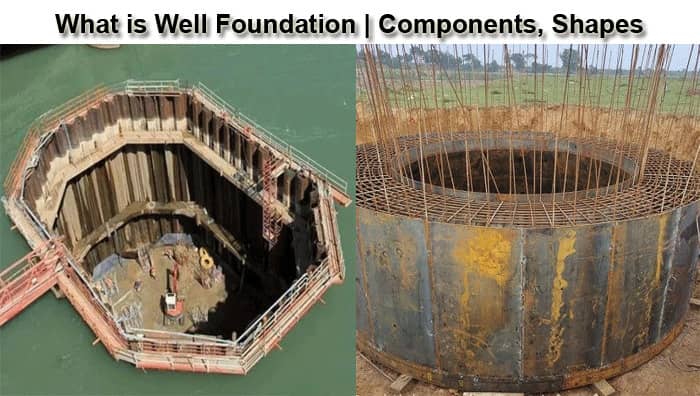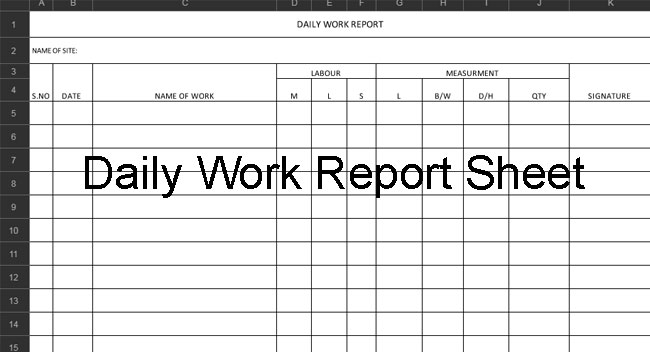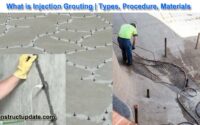What is Well Foundation | Components | Shapes | Advantages | Well Foundation vs Pile Foundation
Introduction To Well Foundation
Since the Roman and Mughal eras, well foundations or caisson foundations have been used as the foundations of bridges and other structures.
Well foundations have been used for centuries in India because they provide strong, underwater foundations for aqueducts, bridges, and monuments. For instance, the well-known Taj Mahal in Agra was built on solid ground.
Similar to open caissons, well foundations are typically used to support bridge piers and abutments because they offer a number of advantages over other forms of deep foundations for such huge projects.

What is Well Foundation?
The deep foundation known as a “well foundation” is typically used below the water line for bridges. The same as an open caisson, a well foundation can be built on a dry bed or after creating a sand island.
Wells can be built on the river bank, floated to the final position, and then grounded in places where the water is moving quickly and deeper than 5 to 6 meters.
When grounding a well, great care must be taken to ensure that the well’s location is precise. Sandbags surround the well to protect it from scour.
Large-diameter foundations, like bridge foundations in rivers, can be created under submerged circumstances using wells or caissons. Caissons are large-width foundations that carry the weight of the superstructure through a layer of brittle soil to a firm stratum at a significant depth.
Under the weight of itself, the well may sunk 500 to 600 mm into the riverbed. The equivalent of a second sinking operation is the sinking of wells on a dry bed.
Well Foundation vs Pile Foundation
- Well foundations offer a stable and substantial foundation for large weights as opposed to a group of piles, each of which is narrow and ineffective.
- The cross-sectional area and bearing capacity of wells are both very enormous.
- It is impossible to drive piles through boulder strata found at greater depths, yet wells can be sunk there.
- Wells have the smallest cross-sectional area, are hollow, and have a significant moment of inertia. Even when the length that is unsupported on the scouring river is very long, they can withstand heavy horizontal and vertical loads.
- The size of the dredge hole, which must be large enough to allow grab to function and to give the requisite sinking effort, limits the minimum size of the well foundation. therefore, unprofitable for light loads.
- When compared to pile foundation, well foundation construction takes substantially longer.
Component of Well Foundation
A. Well Curb
The well curb is intended to sustain the weight of the well with partial support at the bottom of the cutting edge, i.e. when just a section of the cutting edge is in touch with soil and the remainder is maintained only by skin friction.
A three-point support of the cutting edge resting on a log may be considered for design purposes. The load on the cutting edge is unclear since skin friction bears a significant portion of it.
Another unknown is the effective depth of the well curb, because the entire well works as a deep girder to withstand twisting and bending.
Because the load is sporadic, working stress of up to 99% of yield stress may be tolerated. The well curb must also endure force from sand blows as well as light blasting required when a boulder prevents the well from sinking.
B. Cutting Edge
The cutting edge should be as sharp as possible for knifing into the soil without becoming too weak to withstand the various forces caused by boulders, blows, blasting, and so on.
In reality, a 30° angle to the vertical or a slope of I horizontal to 2 vertical has been found to be suitable. The lowest portion of the cutting edge of concrete caissons is wrapped with 12 mm steel plates that are fastened to the concrete using steel straps.
A strong vertical edge is usually supplied along the caisson’s exterior face. In the case of pneumatic caissons, such an edge speeds up sinking and prevents air leakage.
C. Well Steining:
Steining is a form of construction composed of RCC that aids in the transmission of load to the curb. It acts as an enclosure for excavating the earth in preparation for the foundation well’s penetration.
D. Bottom Plug:
After sinking is completed, the bottom of the foundation well is plugged with concrete. The well curb limits the bottom plug and acts as a raft against downward soil pressure.
E. Back-filling:
After the bottom plug concrete is set, the well is dewatered and backfilled with sand or excavated suitable material. Water can sometimes be used in place of sand or excavated material.
F. Top plug:
As specified in the design and drawing, it is a concrete layer with a thickness of roughly 500mm. Over the filling and inside the well dredging hole, a top plug is placed.
G. Well cap:
A well cap is a thick concrete mat that sits on top of the well stening. It is a component of the foundation that is utilized to disperse superstructure loads over the steining.
Shapes of Well Foundation
The following are the common shapes of the well foundation:
- Single circular
- Twin circular
- Double D
- Dumb well
- Twin octagonal
- Twin hexagonal
- Rectangular etc.
The Advantages of Well Foundations Over Pile Foundations are:
- Because of its huge cross-sectional area and stiffness, a well foundation can tolerate the effect of scouring better.
- Because the nature of the strata can be viewed and tested at every point, the depth can be determined as sinking occurs.
- As a result, it may be ensured that it rests on an appropriate bearing stratum of uniform nature and bearing power.
- A good foundation is capable of withstanding significant lateral loads and moments, such as those experienced by bridge piers, tall chimneys, and towers.
- Because well sinking produces no vibrations, there is no risk of damage to nearby structures.





